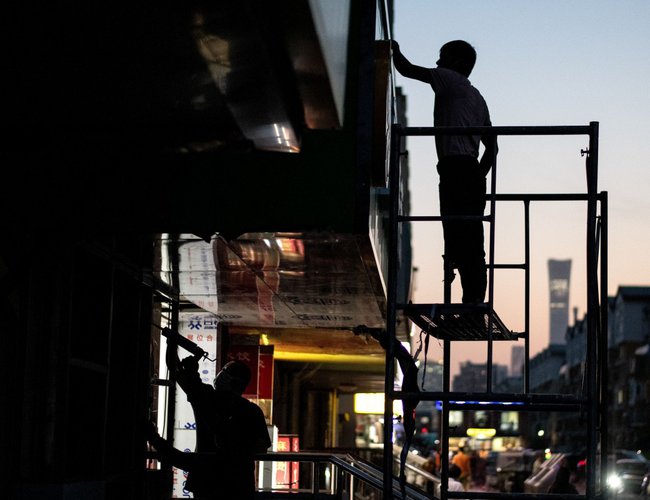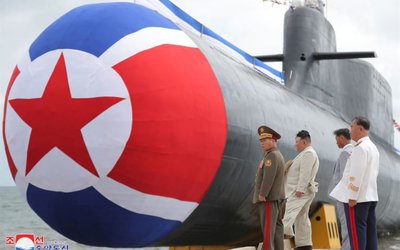
By Finbarr Bermingham
Despite a new outbreak of coronavirus infections forcing authorities to lockdown swathes of Beijing and raising concerns about a second wave of infections throughout China, the deteriorating US-China relationship is now the biggest threat to the Chinese economy, analysts have said.
China’s economy has been slowly recovering from the first period of lockdown between January and March, with industrial output growing steadily and consumption indicators slowly creeping towards growth.
But the nation’s relationship with the United States has been getting progressively worse as the pandemic has spread worldwide and is currently at its lowest ebb in decades.
“Absent a significant second wave of the virus, the biggest downside risk is escalation of US-China tensions,” said Bo Zhuang, chief China economist at TS Lombard, a research house.
The China issue will always be an important topic during the US presidential election, which could cause disruption in the Chinese economy
“There have been no mass manufacturing lay-offs. As a result of the better-than-expected export growth in April and May, the labour market held up more strongly than we had expected,” Zhuang added. “We believe that China is on track to post low positive growth of 1 per cent in the second quarter. Thus, we stick to our forecast for overall [gross domestic product] growth in 2020 at 2 per cent.”
Meanwhile, the threat of Washington sanctioning China for its plan to impose a new national security law on Hong Kong remains, along with a worrying military build-up in the South China Sea. A collapse in relations on the Korean peninsula could also add tension to the superpower rivalry, while both sides are said to be adding to their respective “entity lists”, which would punish firms doing business in the other nation.
Lu Zhengwei, chief economist at the China Industrial Bank, said that US relations would be the biggest risk to the world’s second largest economy for the rest of the year.
“The China issue will always be an important topic during the US presidential election, which could cause disruption in the Chinese economy, mostly in market expectations,” Lu said.
Coronavirus pandemic creates ‘new Cold War’ as US-China relations sink to lowest point in decades
Coronavirus pandemic creates ‘new Cold War’ as US-China relations sink to lowest point in decades
The phase one trade deal signed in January was seen as the single positive thread in the US-China dynamic, but now appears to be in danger.
China is nowhere near to fulfilling its purchasing targets set out for 2020. Soybean purchases are returning strongly, but it remains to be seen if increased imports of the politically expedient crop will be enough to stop US President Donald Trump from torpedoing the deal in an election year in which China appears to be a crucial factor.
Soybean sales accelerated in the week to May 29, with 854,000 tonnes of export commitments for this marketing year and next, compared to 531,000 tonnes the week before.
The strong rebound appears to have dampened media speculation that Beijing had ordered state buyers to stop purchasing US beans in response to Washington announcing Hong Kong was no longer autonomous from mainland China due to the national security law.
Even US agriculture officials do not expect China to meet the overall agricultural purchasing target of US$33.4 billion for this year, while it remains miles behind purchase targets of energy and manufactured goods.
“These targets were always ridiculous, there is no way they can be met,” said a US representative in China, who did not want to be named due to the sensitivity of the issue. “The conditions cannot be filled on soybeans, we simply could not compete with cheaper Brazilian beans through March and April. We were aiming to export 36 million metric tonnes to China this year, but now if we can do 30 million there will be a big celebration. But I am not optimistic about that.”
While China is supposed to be buying US$200 billion in additional US goods from 2017’s baseline figures, imports of American products actually fell by 13.5 per cent in May from a year earlier, when tariffs were in full swing and shipments were already very low.
US Secretary of State Mike Pompeo is slated to meet Yang Jiechi, a Communist Party Politburo member and top diplomat, in Hawaii this week in a bid to defuse rising tensions.
The US has sent three aircraft carrier battle groups to patrol waters in the South China Sea near where China has built artificial islands in an attempt to claim control over international territory, the largest concentration of US naval power in the Pacific since the high point of North Korean tensions in 2017.
The editor of state-owned tabloid Global Times, Hu Xijin, took to Twitter to suggest that both sides realise things had gone “too far”.
“Such news is fermenting, indicating that the public thinks China-US tensions have gone too far and they expect an ease of the ties. If the meeting is realised, it shows the authorities of the two sides also think the tensions have become a risk that may spiral out of control,” he wrote.
A note from consultancy Beacon Policy Advisors said that the meeting “could offer some opportunity for a cooling off of tensions and higher-level positive statements, but is unlikely to result in a sea-change in the relationship”.
Beacon’s analysts added that “while Trump sees political value in attacking China and blaming it for the pandemic, he also wants to avoid a break in the phase one trade deal that results in China halting or limiting its promised agricultural purchases”.
I think at this point in time, the trade deal is the only positive element of the relationship
Six months in, premonitions from some quarters that phase one was just a “sticking plaster” in the wider relationship appear to be borne out, with analysts warning that even that fragile band aid is slipping off.
“I think at this point in time, the trade deal is the only positive element of the relationship,” said Michal Meidan, director of the China Energy Programme at the Oxford Institute for Energy Studies. “It seems to be keeping the conversation going, keeping the lines of communication open. If that goes, you’re left with virtually nothing.”
Bert Hofman, director of the East Asian Institute at the National University of Singapore, said the tariffs that had been imposed over the past two years had put pressure on global value chains anchored in China.
“As does a rapidly expanding ‘entities list’ and other restrictions on trade in US technology with Chinese entities – directly or indirectly,” said Hofman, a former World Bank director for China.
“More trade policy moves could aggravate this, and it will be policies, not viruses, that will determine the shape of global value chains to come.”“More trade policy moves could aggravate this, and it will be policies, not viruses, that will determine the shape of global value chains to come.”
Source: South China Morning Posts
- Students, Police Clash On US Campuses Over Gaza
- Apr 25, 2024
- Israel Procures Tents To Evacuate Rafah Residents For Ground Offensive
- Apr 25, 2024
- Nepal Gifts Two Elephants To Qatar
- Apr 24, 2024
- Israel Urges Residents In Part Of Northern Gaza To Evacuate
- Apr 24, 2024
- US Senate Takes Up Aid For Ukraine, Israel, Indo-Pacific
- Apr 24, 2024
















